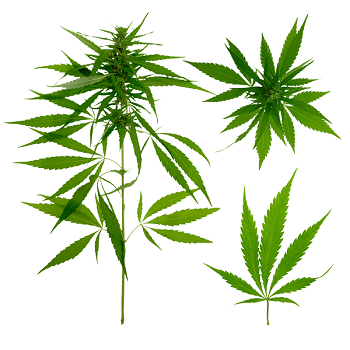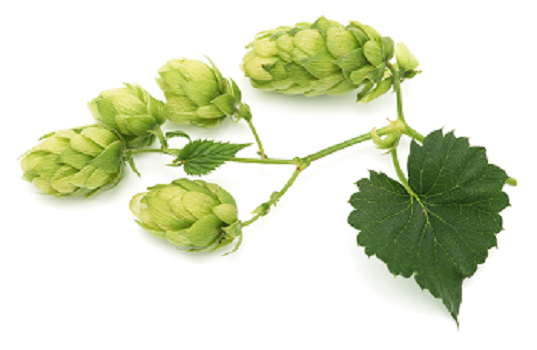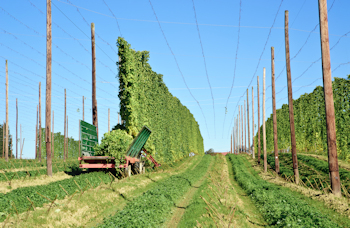Hemp versus Hops: Past, Present, and Future for an Unlikely Pairing
A closer look at the similarities and differences — as well as the chemicals and compounds — that weave these two plants together in natural synergy.
Hemp and hops may seem like an unlikely pairing. After all, one is a source for textiles and medicines while the other is a key ingredient in beer — not exactly an intuitive connection. In actuality the two are closely related, not necessarily in use (although that is changing), but with regards to origin, genetics, taxonomy classification, and other key characteristics.
These two plants also have a number of chemicals and compounds that bind them together, which we explore below, as well as taking a few moments to comment on the emerging practical and economic implications of the hemp vs hops relationship.
The Cannabaceae Family
Hemp and hops both belong to Cannabaceae, a small family of flowering plants which currently includes 170 species grouped in 11 genera, including Cannabis (hemp, marijuana) and Humulus (hops). Modern phylogenetics indicate the relationship between Cannabis and Humulus is considerably stronger than between other genera of the Cannabaceae family, which may in part explain their numerous similarities.
Major Differences between Hemp and Hops
Although Cannabis and Humulus are closely related evolutionarily, they are largely unrelated in physical appearance and use.

-
Cannabis is considered a standing herb; hemp grows as tall single main stalks with few leaves and branches whereas Marjuana grows typically as short bushy plants.
-
Hemp & Marijuana plants produce female flowers.
-
Hemp is cultivated for production of fiber, oil, textiles, and medicinal extracts. Closely related Marijuana is grown for medicinal (and recreational) use as well.

Humulus is considered a twining or trailing, interwoven herb; hops plants grow quite tall and produce long vines upwards of 20-30 ft in length.
-
Hops produce distinctive female flower cones.
-
Hops have been used for several hundred years as a predominant ingredient in beer. The resin of hop flowers is used to produce distinct bitterness tones, while purported antimicrobial qualities are used to extend shelf life of the product.
Hemp vs Hops – Cultivation and Processing
The similarities between hemp and hops extend to include many facets of cultivation:
-
As with cannabis, female unpollinated hops plants typically display the richest production of resins and oils and are therefore selectively grown.
-
Cannabis and Humulus both exist as "varietals", linking differences in strains and growth locales with distinct flavor profiles.
-
Strains can be naturally cross-pollinated, therefore conditions to ensure proper growth of distinct strains (e.g. low-THC hemp) are important considerations.
-
Each plant variety brings its own “preferences” for harvesting times, which vary with the strain, location, soil conditions, and other parameters.
-
Both types of flowers display intrinsic signs of ripeness, and determination of the right time to harvest lies in the eyes, nose, and hands of the grower.
-
Both types of flowers can be hand picked and trimmed according to desired readiness, and both require immediate drying to prevent mold and rot.
 The differences primarily arise in the harvesting and processing steps, largely due to the physical differences in the plants. Hemp for practical use is typically harvested for seed oil or stalks. The equipment used in the process includes implements and techniques specific for the desired product — fiber harvests make use of longer cuts whereas seed harvests raise the height, targeting only the upper portion of the plant. Hops harvesting (example shown right) focuses entirely on collecting the flower cones, as those are what are used in brewing. Vines are cut down en masse and the flower cones are then separated from the rest of the plant matter.
The differences primarily arise in the harvesting and processing steps, largely due to the physical differences in the plants. Hemp for practical use is typically harvested for seed oil or stalks. The equipment used in the process includes implements and techniques specific for the desired product — fiber harvests make use of longer cuts whereas seed harvests raise the height, targeting only the upper portion of the plant. Hops harvesting (example shown right) focuses entirely on collecting the flower cones, as those are what are used in brewing. Vines are cut down en masse and the flower cones are then separated from the rest of the plant matter.
The Terpene Connection
Apart from lineage, the main similarities between cannabis and hops are the production of aromatic terpene compounds which underlie the complex flavors and fragrances of both plants. These highly volatile aromatic cyclic hydrocarbon compounds vary in form and complexity in step with the diverse variety of hops or cannabis used in brewing or consumption.
Over the ages of cultivation, certain classes and types of terpenes have been selected against (or selected for) in achieving the desired profiles for use. Mycrene, caryophyllene, humulene, limonene, and pinenes are some of the most common. All terpenes have unique chemistries, aromas, and biological effects as well.
The terpene contents of Cannabis are more diverse than Humulus, although hops do contain myrcene, caryophyllenes and others, some of which have known and pronounced physiological effects. For instance, caryophyllene is believed to interact with endocannabinoid receptors and may increase the bioavailability of cannabinoids such as THC and CBD.
Buds & beer
Due to the natural synergy between the two, it seems natural that beer and cannabis be explored for terpenes and chemical profiles that combine to produce desirable qualities and effects.

Beer and alcohol firms have been watching the cannabis industry closely over the years, and some are even getting involved directly. There are certain competitive advantages of cannabis over alcohol — the fact that alcohol can be consumed only as a liquid versus the multitude of consumables routes of cannabis is a key difference. Some have even postulated that cannabis products could begin to outcompete alcohol in the coming years.
Hemp infused beers that contain no CBD or THC have been on the market for years, but as cannabis continues to become more accepted legally and alcohol producers become further invested, we will likely see new products — such as CBD infused alcoholic beverages — gain a greater presence.
Clearly, the relationship between hemp and hops is both longstanding and continuing to evolve, with a number of exciting developments on the horizon. Research into the diverse yet complementary qualities and chemical profiles of hemp versus hops will only make the field more interesting.
Cheers to greater and greener things to come.
Visit the LabX Cannabis Laboratory application page for equipment and product listings as well as content dedicated to the field of cannabis science.
View our expanding catalog of Cannabis Laboratory content for further insight.
Article updated April 2021










